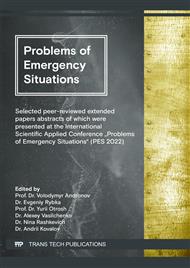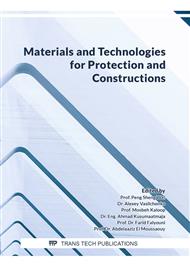[1]
S. Guzii, Y. Otrosh, O. Guzii, A. Kovalov, K. Sotiriadis, Determination of the Fire-Retardant Efficiency of Magnesite Thermal Insulating Materials to Protect Metal Structures from Fire, Materials Science Forum. 1038 (2021) 524–530.
DOI: 10.4028/www.scientific.net/msf.1038.524
Google Scholar
[2]
P. Krivenko, S. Guzii, et al., Effect of thickness of the intumescent alkali aluminosilicate coating on temperature distribution in reinforced concrete. Journal of Building Engineering. 8 (2016) 14–19.
DOI: 10.1016/j.jobe.2016.09.003
Google Scholar
[3]
A. Kravchenko, S. Guzii, Determining the fire resistance properties of timber, protected by geocement-based coatings. Eastern-European Journal of Enterprise Technologies. 1(5) (2015) 38–41.
DOI: 10.15587/1729-4061.2015.36843
Google Scholar
[4]
N.T. Abdel-Ghani, H.A. Elsayed, S. A. Moiled, Geopolymer synthesis by the alkali-activation of blastfurnace steel slag and its fire-resistance, HBRC Journal. 14(2) (2018) 159–164.
DOI: 10.1016/j.hbrcj.2016.06.001
Google Scholar
[5]
J. Sarazin, C.A. Davy, et al., Flame resistance of geopolymer foam coatings for the fire protection of steel, Composites Part B: Engineering. 222 (2021) 109045.
DOI: 10.1016/j.compositesb.2021.109045
Google Scholar
[6]
M.-B. Watolla, G.J.G. Gluth, et al., Intumescent geopolymer-bound coatings for fire protection of steel, Journal of Ceramic Science and Technology. 8(3) (2017) 351–364.
Google Scholar
[7]
L. Salmabanu, D. Nicolaides, I. Luhar, Fire Resistance Behaviour of Geopolymer Concrete: An Overview, Buildings. 11(3) (2021) 82.
DOI: 10.3390/buildings11030082
Google Scholar
[8]
D.C. Comrie, W.M. Kriven, Composite cold ceramic geopolymer in a refractory application, Ceramic Transactions. 153 (2003) 211–225.
DOI: 10.1002/9781118406892.ch14
Google Scholar
[9]
M. Sukhanevich, S. Guzii, The effect of technological factors on properties of alkali aluminosilicate systems used for preparation of fireproof coatings. Refractories and Industrial Ceramics. 45 (2004) 217–219.
DOI: 10.1023/b:refr.0000036733.85631.f1
Google Scholar
[10]
K. Sotiriadis, S. Guzii, et al., Thermal Behavior of an Intumescent Alkaline Aluminosilicate Composite Material for Fire Protection of Structural Elements, Journal of Materials in Civil Engineering. 31(6) (2019) 04019058.
DOI: 10.1061/(asce)mt.1943-5533.0002702
Google Scholar
[11]
K. Sotiriadis, S. Guzii, et al., The effect of firing temperature on the composition and microstructure of a geocement-based binder of sodium water-glass, Solid State Phenomena. 267 (2017) 58–62.
DOI: 10.4028/www.scientific.net/ssp.267.58
Google Scholar
[12]
Š. Hýsek, M. Frydrych, et al., Fire-Resistant Sandwich-Structured Composite Material Based on Alternative Materials and Its Physical and Mechanical Properties, Materials. 12 (2019) 1432.
DOI: 10.3390/ma12091432
Google Scholar
[13]
J.W. Gu, G.C. Zhang, et al., Study on preparation and fire-retardant mechanism analysis of intumescent flame-retardant coatings, Surface and Coatings Technology. 201 (2007) 7835–7841.
DOI: 10.1016/j.surfcoat.2007.03.020
Google Scholar
[14]
X. Peng, H. Li, Q. Shuai, L. Wang, Fire Resistance of Alkali Activated Geopolymer Foams Produced from Metakaolin and Na2O2, Materials. 13 (2020) 535.
DOI: 10.3390/ma13030535
Google Scholar
[15]
P. Krivenko, S. Guzii, R. Hela. The influence of cavitation treatment on nanostructuring of alkali aluminosilicate binder for intumescent coatings, Materials Science Forum. 908 (2017) 63–70.
DOI: 10.4028/www.scientific.net/msf.908.63
Google Scholar
[16]
L. Bodnarova, S. Guzii, et al. Nano-structured alkaline aluminosilicate binder by carbonate mineral addition, Solid State Phenomena. 276 (2018) 192–197.
DOI: 10.4028/www.scientific.net/ssp.276.192
Google Scholar
[17]
V. Kyrychok, P. Kryvenko, S. Guzii. Influence of the СaО-containing modifiers on the properties of alkaline alumosilicate binders, Eastern-European Journal of Enterprise Technologies. 2(6-98) (2019) 36–42.
DOI: 10.15587/1729-4061.2019.161758
Google Scholar
[18]
S. Guzii, T. Kurska, et al. Features of the organic-mineral intumescent paints structure formation for wooden constructions fire protection. IOP Conf. Ser.: Mater. Sci. Eng. 1162 (2021) 012003.
DOI: 10.1088/1757-899x/1162/1/012003
Google Scholar
[19]
S. Duquesne, S. Magnet, C. Jama, R. Delobel, Intumescent paints: Fire protective coatings for metallic substrates, Surface and Coatings Technology. 180 (2004) 302–307.
DOI: 10.1016/j.surfcoat.2003.10.075
Google Scholar
[20]
T. Mariappan, Recent developments of intumescent fire protection coatings for structural steel: A review, Journal of Fire Sciences. 34 (2016) 120–163.
DOI: 10.1177/0734904115626720
Google Scholar
[21]
S. Duquesne, P. Bachelet, et al., Influence of inorganic fillers on the fire protection of intumescent coatings, Journal of Fire Sciences. 31 (2013) 258–275.
DOI: 10.1177/0734904112467291
Google Scholar
[22]
V. Petránek, S. Guzii, L. Nevrivova, D. Zezulova, Thermal Insulating Materials for Energy Storage Application, Advanced Materials Research. 911 (2014) 30–35.
DOI: 10.4028/www.scientific.net/amr.911.30
Google Scholar
[23]
V. Petranek, S. Guzii, K. Sotiriadis, L. Nevrivova, Study on the Properties of Geocement Based Thermal Insulating Materials for High Temperature Technical Appliances, Advanced Materials Research. 734–737 (2013) 2356–2359.
DOI: 10.4028/www.scientific.net/amr.734-737.2356
Google Scholar
[24]
P. Kryvenko, Y. Tsapko, S. Guzii, A. Kravchenko, Determination of the effect of fillers on the intumescent ability of the organic-inorganic coatings of building constructions, Eastern-European Journal of Enterprise Technologies. 5(10–83) (2016) 26–31.
DOI: 10.15587/1729-4061.2016.79869
Google Scholar
[25]
L.N. Vakhitova, K.V. Kalafat, Structural fire protection systems for steel, Journal of Industrial construction and engineering structures. 4 (2015) 28–32.
Google Scholar
[26]
L.N. Vakhitova, K.V. Kalafat, Fundamentals of fire protection of steel structures, Journal of Industrial construction and engineering structures. 4 (2015) 23–27.
Google Scholar



